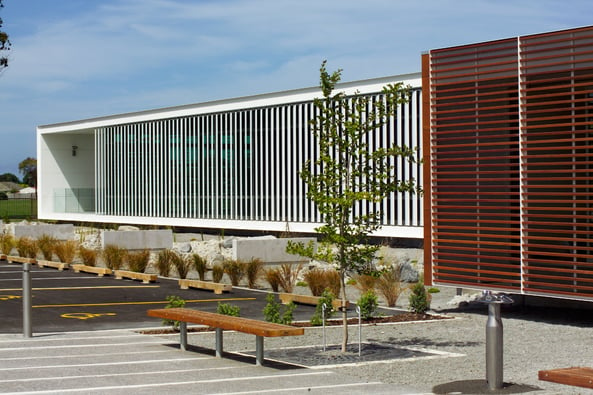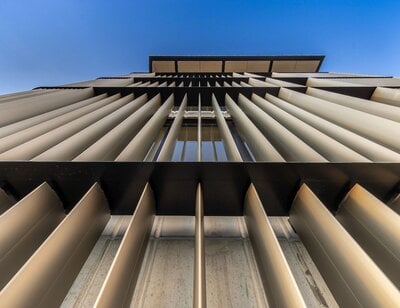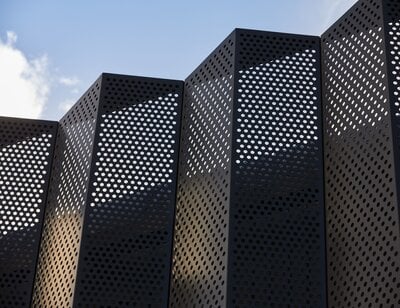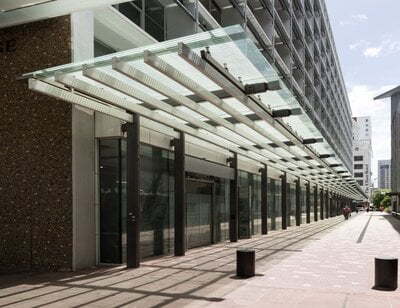
The Importance of Sun Shading:
The sun may be 149,600,000 kms away, but its impact is felt constantly, either through its presence or absence as the earth rotates around it. Composed of 70% hydrogen, 28% helium and 2% carbon, oxygen and nitrogen, the surface is some 5,538℃ (10,000℉). To put that in context, the temperature of lava is ‘just’ 1,141℃ (2,085℉). Gold will melt at 1,062℃ (1,943℉).
The temperature dissipates as you move from the sun’s surface. However, even on the earth's surface some 150 million kms away, the temperature can still be significant. LST, or Land Surface Temperature, is the radiative skin temperature of the land derived from solar radiation. In essence, it’s how hot the surface feels. The hottest place on earth (by LST) is the Lut Desert in Iran, posting a record of 70.7℃ (159.3℉) in 2005. It should be noted the shrublands of Queensland were recorded at 69.3℃ (156.7℉) in 2003.
As for commercial buildings in urban City Centres, NASA has observed the heat buildup in cities to regularly climb above the temperatures found in nearby deserts. It’s called the Urban Heat Island Effect and is known to increase the temperature by up to 5℃ (41℉) vs the surrounding area.
Whilst this article generally concerns itself with the impact of the sun and importance of sun shading for the occupants of a building, it would be remiss not to mention the case of a melting car parked in Eastcheap, within the City of London. The nearby 37 storey high ‘Walkie Talkie’ skyscraper on Fenchurch Street was under construction in 2013 when Martin Lindsay discovered parts of his parked Jaguar had melted (badge, wing mirror, panels) as a direct result of the reflection off the skyscraper. The building was eventually fitted with a brise soleil sun shade to deflect sunshine.
Occupant Comfort:
Occupant comfort can be broadly separated into visual comfort and thermal comfort. The latter, thermal discomfort, is concerned with ambient temperature. In particular, the need to regulate this to between 18℃ (64℉) and 24℃ (75℉). Prolonged exposure outside of this range is considered to carry a health threat, which is why the World Health Organisation provides guidance on temperatures and related duration of exposure. The guidelines however specifically address thermal comfort for the housing environment, and do not extend to the working (office) environment.
Thermal comfort within the working environment is more commonly discussed in relation to the Predicted Mean Vote (PMV) and Predicted Percentage of Dissatisfied (PPD). It is the work of Povl Ole Fangar, a Professor from Denmark who is also widely credited with his work linking poor air quality to asthma in children (within the home) and decreased productivity (within the workplace).
The basis of Fangar’s work is that human thermal comfort is based on skin temperature and sweat secretion. To be considered ‘comfortable’, these two factors have to be balanced within an acceptable range. By experimenting with placing subjects in a Climate Chamber, Fangar analysed the responses when adjusting specific variables (environmental: air velocity, mean radiant temperature and relative humidity) and (personal: activity levels and insulation).
These experiments led to the development of the PMV and PPD models. In these, PMV predicts the temperature at which the average occupant will be comfortable. PPD predicts what portion of occupants will be unhappy with a specific set of temperature and conditions.
Whilst there have been some objections to the work of Fangar (for example, it failed to take into account cultural differences in temperature tolerance) it still forms the basis for today's thinking. Much of it being enshrined within the globally recognised ASHRAE 55 and ISO 7730 standards, which define thermal comfort as “that condition of mind that expresses satisfaction with the thermal environment”.
PMV:
Measured on a 7 point scale (from -3/Cold to +3/Hot), equilibrium is when an occupants heat loss is in balance with internal heat production. This balance, as previously noted, is affected by levels of activity undertaken and clothing insulation.
PPD:
To take into account differing levels of satisfaction with thermal comfort on the occupants, Fangar created PPD to assist in determining the percentage of occupancy comfort at points on the PMV scale. For example, at +1 PMV, the PPD tells us 20% of occupants are likely to be dissatisfied. At +2, the number of dissatisfied increases to 75%.
As regards ASHRAE 55, the standard requires a 80% satisfaction rate. This equates to a PMV range of between -0.7 and +0.7 for existing buildings and -0.5 and +0.5 for new buildings.
As for the perfect temperature to get the most productivity gains, one study concluded the ideal temperature for an office sits between 22℃ (72℉) and 25℃ (77℉). This is likely warmer than some would expect and goes against the widely held hypothesis that cooler temperatures increase productivity (through ‘keeping you awake’ and ‘making you move’).
Visual Comfort:
We are primarily concerned with issues of sun glare but should deviate briefly to emphasise the wider importance of lighting within a building, which is felt not just by occupants physically but also financially.
Light has long affected the design of buildings, from the X shaped buildings in London during the 1950’s to the need for higher ceilings and larger windows in the decades (and centuries) prior. Indeed, there is still an easement in English Law which essentially grants the ‘Right to Light’, based on an ancient Roman Law. For a building owner, should he/she have tallied 20 years with a window into which daylight comes in, no building can be built which would block the light. This has particular relevance to commercial property and is still the subject of court battles (see HKRUK II vs Heaney).
More relevant and immediate is the potential cost savings associated with allowing an abundance of natural light into a building. It has been estimated that 30% to 50% of energy costs for an office is spent on lighting. Increasing the natural light can reduce this cost burden significantly.
There is also a body of work associated with productivity gains from natural lighting. For example, Wal-Mart saw sales significantly higher in the half of a building which used lighting via skylights. Indeed, it has been reported that retail sales may be increased by up to 40% through the use of natural lighting.
Finally, there can be no more important benefit to be derived by natural light than that it has on health. This can be perfectly highlighted by referencing the American Association for the Advancement of Science study. This study found postoperative patients with a window recovered quicker and required less pain medication (suggesting having a view was also important).
Why is this important?
The preceding information provides a brief overview of multiple factors which support the main thrust of this article - that sun shading is of critical importance. The use of natural light has many benefits but unchecked, the otherwise positive aspects become overwhelmingly negative. Excessive, direct sunlight can move the mercury in the wrong direction and as detailed within Fangar’s work, a PMV in excess of +0.5 in a new building will result in significant occupant thermal discomfort. This ‘overheating’ is not only dangerous to health but also has significant implications for productivity. For example, where the temperature moves upwards of 25℃ (77℉), productivity starts to drop by 2% for each additional ℃, as represented as P % = 2 x (Temp, ℃) - 50.
Visual fatigue from sun glare, along with the associated increase of likelihood in experiencing physical discomfort (headaches/migraine) and possible irreversible eyesight deterioration, make for a case against unchecked sunlight. This is particularly relevant at specific times of the day (as at certain times of the year).
Benefits of Sun Shading:
Many of the benefits are associated with countering the negative effects as detailed in the previous section. However, it is not all about fighting the negative effects of sunshine.
The reduction in the heat load through the use of sun shading will realise significant savings in building running costs. This is achieved by keeping the radiant heat from the surface of the building. The correct sun-shading will also reduce the radiant heat load from entering the building.
For occupants at the perimeter of the building, it would be logical to hypothesize an increased likelihood of dissatisfaction, the position of these occupants may well help identify those who would be the first to sit outside the acceptable PPV range.
A reduction in glare for occupants is beneficial for both health and productivity gains. Indeed, correctly angled and calculated sun shading should be seen as a way to effectively increase productivity within a building.
It should also be noted that sun shading often adds to the architectural aesthetic of the building envelope. An external benefit which cannot be underestimated given the proclivity of mankind to judge on first impressions and make assumptions based on those impressions (beneficial for selling space).
Lastly, sun shading can be incorporated or retro-fitted to an existing facade.
Key Considerations:
Every facade will have a variation in requirements for optimal sun shading and no two buildings will be identical in their needs.
The geographical position, proximity to other buildings (and their design) and the wider natural environment all need to be considered. The angles of the sun and local wind pressures can all have a major effect on the goal of not only creating something aesthetically pleasing but also practical, which can protect against unwanted heat gain in summer whilst maximising that gain in winter.
As well as the positional elements, there are a number of considerations associated with the materials used. For example, should the finish be powder coated or anodised? Indeed, the material used may be impacted by considerations of structural integrity. There are always cost implications. In New Zealand, proximity to the ocean is also a factor with regard to material and finishes selections.
Some sun shading is fixed but can also be operable, allowing for alterations depending on the mood of the occupant. This is particularly relevant in accommodation.
Finally, whilst a number of products are available for standard sun-shading, there is considerable (and growing) interest in something bespoke, which is designed for aesthetics and adding to the architectural intent as it is for achieving practical benefits.
Harnessing the Sun:
To aid in calculating the requirements for sun shading we have developed a number of free tools. These can be used to:
- Calculate the shading provided by either a horizontal or vertical louvre system.
- Calculate the shading provided by vertical fins on a window or a wall.
- Visualise the degree to which horizontal overhang shares a window during the year.
- Gain visual feedback about the performance of a horizontal window overhang.
Sun shading can be as beneficial visually as it is practically. If you would like more information about what is possible or to discuss the topic further, then please get in contact with us.








